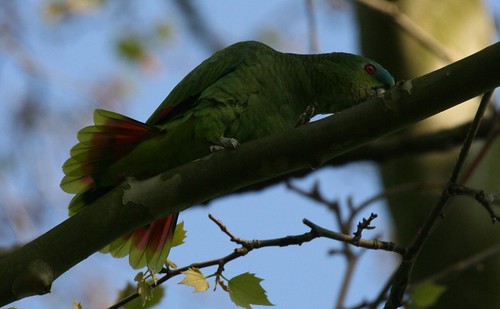 Hybrid Amazon parrot. Conveying not to mess with it in Wiesbaden, GermanyAt the start of May we got a few days off from work and decided to investigate the City Parrots of Germany. Our first stop was at Schlosspark Biebrich Wiesbaden.
Hybrid Amazon parrot. Conveying not to mess with it in Wiesbaden, GermanyAt the start of May we got a few days off from work and decided to investigate the City Parrots of Germany. Our first stop was at Schlosspark Biebrich Wiesbaden.
We got the location from the Papageien vor der Haustür (Parrots at the front door) website. If you reed the German language it is a site I can dearly recommend with a lot of Information on Germany's past and present wild parrots. Special attention is brought to the Wiesbaden Ring-necked parakeets (Psittacula krameri). The Wiesbaden area being home ground to author; Detlev Franz, whom we were happy to meet.
 Ring-necked parakeet pair, Wiesbaden, GermanySpecial to Wiesbaden is a small population of Amazon parrots. Detlev describes on his site how Mondchen, the Orange Winged Amazon (Amazona amazonica), and Ringel, the Blue fronted Amazon (Amazona aestiva) are the probable founders of this population back in 1998.
Ring-necked parakeet pair, Wiesbaden, GermanySpecial to Wiesbaden is a small population of Amazon parrots. Detlev describes on his site how Mondchen, the Orange Winged Amazon (Amazona amazonica), and Ringel, the Blue fronted Amazon (Amazona aestiva) are the probable founders of this population back in 1998.
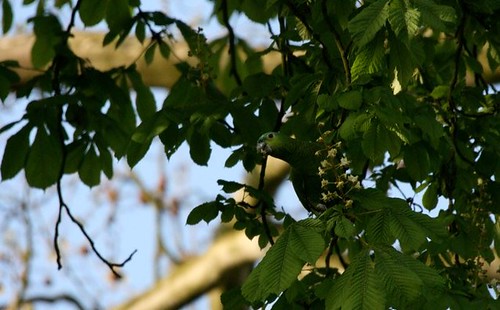 Amazon Hybrid eating chestnut flowers, Wiesbaden, GermanyWe were lucky enough to observe the Amazons on the evening of our arrival and the following morning. The parrots are inactive during the largest part of the day. Presumingly sleeping in their nests like the Amazons we observed in Temple City and San Diego.
Amazon Hybrid eating chestnut flowers, Wiesbaden, GermanyWe were lucky enough to observe the Amazons on the evening of our arrival and the following morning. The parrots are inactive during the largest part of the day. Presumingly sleeping in their nests like the Amazons we observed in Temple City and San Diego.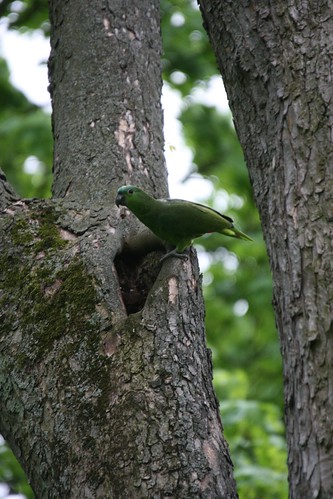 Feral Amazon hybrid inspecting nests, Wiesbaden, GermanyOn our images we only see birds that are intermediate between the two founding species. Detlev told us that Mondchen had died and that Ringel had paired up with one of his offspring. If the hybrids are fertile is unclear. Detlev claims they are but other authors doubt this. If the population keeps expanding we will know more.
Feral Amazon hybrid inspecting nests, Wiesbaden, GermanyOn our images we only see birds that are intermediate between the two founding species. Detlev told us that Mondchen had died and that Ringel had paired up with one of his offspring. If the hybrids are fertile is unclear. Detlev claims they are but other authors doubt this. If the population keeps expanding we will know more.
We saw the birds inspecting possible nest sites but non were entered while we were present. We found 3 pairs in the park.
Schlosspark Biebrich is also home to two Psittacula species: Ring-necked and Alexandrine (Psittacula eupatria) parakeets. Both Species are abundant in the park. Ring-necks are more numerous but we got the distinct impression the Alexandrines are the upcoming species. The roosting tree of the Alexandrines has never been found so it is hard to do a good estimate. Unlike the Alexandrines in Amsterdam and Haarlem the Wiesbaden Alexandrines do not roost with the Ring-necks. Nor did we see any hybrids.
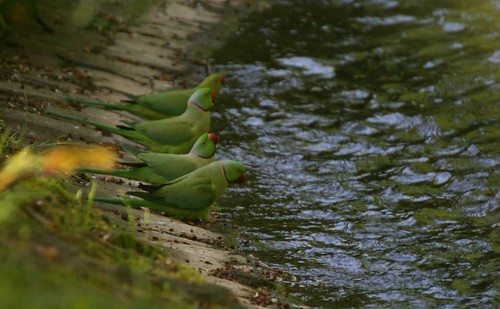 Ring-necked parakeets drinking at the edge of a meadow, Wiesbaden, GermanyDetlev showed us the roosting tree of the Wiesbaden Ring-necked parakeets. Some 500 parakeets came in to roost. At this time of year the females remain on the nest during the night, brooding chicks and eggs. The present percentage male birds compared to later in the year is used by Detlev as an indication of the breeding population.
Ring-necked parakeets drinking at the edge of a meadow, Wiesbaden, GermanyDetlev showed us the roosting tree of the Wiesbaden Ring-necked parakeets. Some 500 parakeets came in to roost. At this time of year the females remain on the nest during the night, brooding chicks and eggs. The present percentage male birds compared to later in the year is used by Detlev as an indication of the breeding population.
 Alexandrine Parakeets (Psittacula eupatria) leafbathing in the rain, Wiesbaden, GermanyAll in all a great day with plenty of photo opportunity.
Alexandrine Parakeets (Psittacula eupatria) leafbathing in the rain, Wiesbaden, GermanyAll in all a great day with plenty of photo opportunity.
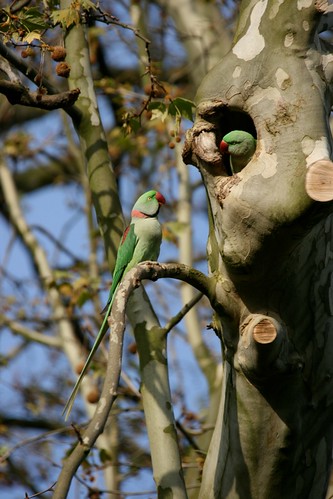 Alexandrine Parakeets (Psittacula eupatria) at a nest, Wiesbaden, Germany
Alexandrine Parakeets (Psittacula eupatria) at a nest, Wiesbaden, Germany